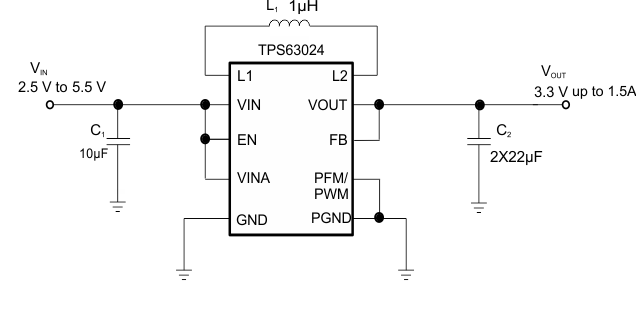ZHCSDM2A November 2014 – December 2014 TPS63024 , TPS630241 , TPS630242
PRODUCTION DATA.
- 1 特性
- 2 应用范围
- 3 说明
- 4 修订历史记录
- 5 Pin Configuration and Functions
- 6 Specifications
- 7 Detailed Description
- 8 Application and Implementation
- 9 Power Supply Recommendations
- 10Layout
- 11器件和文档支持
- 12机械、封装和可订购信息
1 特性
- 支持降压和升压运行间自动和无缝转换的实际降压或升压运行
- 输入电压范围 2.3V 至 5.5V
- 1.5A 持续输出电流:VIN ≥ 2.5V,VOUT = 3.3V
- 可调和固定输出电压
- 在降压或升压模式中效率高达 95%,而在 VIN = VOUT 时,效率高达 97%
- 2.5MHz 典型开关频率
- 运行静态电流 35μA
- 集成软启动
- 省电模式
- 真正关断功能
- 输出电容器放电功能
- 过热保护和过流保护
- 宽电容值选择
- 小型 1.766mm x 2.086mm,20 引脚晶圆级芯片尺寸 (WCSP) 封装
2 应用范围
- 手机、智能电话
- 平板个人电脑
- 个人电脑和智能手机配件
- 负载点稳压
- 电池供电类 应用
3 说明
TPS63024 是一款高效、低静态电流降压-升压转换器,此转换器适用于输入电压会高于或低于输出的应用。在升压模式下,输出电流可高达 1.5A,而在降压模式下,输出电流可高达 3A。开关内的最大平均电流被限制在 3A(典型值)。TPS63024 根据输入电压在降压或升压模式之间自动切换,以便在整个输入电压范围内调节输出电压,从而确保两个模式间的无缝转换。此降压-升压转换器基于一个使用同步整流的固定频率、脉宽调制 (PWM) 控制器以获得最高效率。在低负载电流情况下,此转换器进入省电模式,以便在整个负载电流范围内保持高效率。有一个使用户能够在自动 PFM/PWM 模式运行和强制 PWM 运行之间进行选择的 PFM/PWM 引脚。在 PWM 模式期间,通常使用一个 2.5MHz 的固定频率。使用一个外部电阻分压器可对输出电压进行编程,或者在芯片上对输出电压进行内部固定。转换器可被禁用以最大限度地减少电池消耗。在关机期间,负载从电池上断开。此器件采用 20 引脚,1.766mm x 2.086 mm,WCSP 封装。
器件信息(1)
| 器件型号 | 封装 | 封装尺寸(标称值) |
|---|---|---|
| TPS63024 | 芯片尺寸球状引脚栅格阵列 (DSBGA) (20) | 1.766mm x 2.086mm |
| TPS630241 | ||
| TPS630242 |
- 如需了解所有可用封装,请参阅产品说明书末尾的可订购产品附录。
器件比较
| 器件编号 | VOUT | |
|---|---|---|
| TPS63024 | 可调节 | |
| TPS630241 | 2.9V | |
| TPS630242 | 3.3 V | |
典型应用

效率与输出电流间的关系
